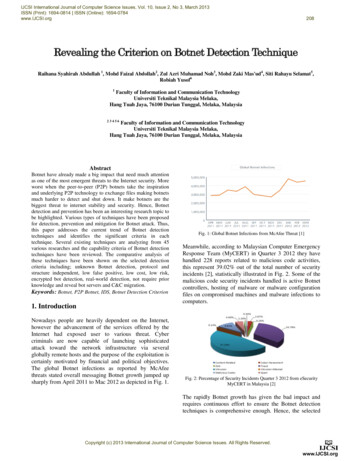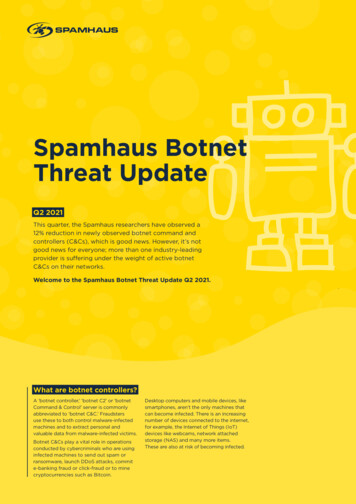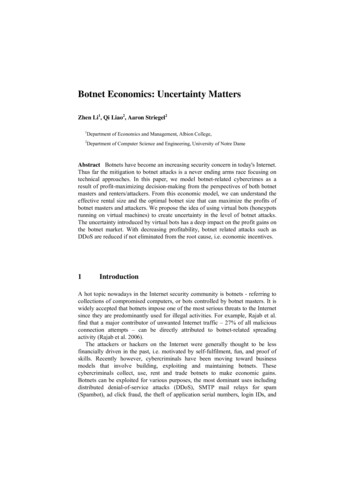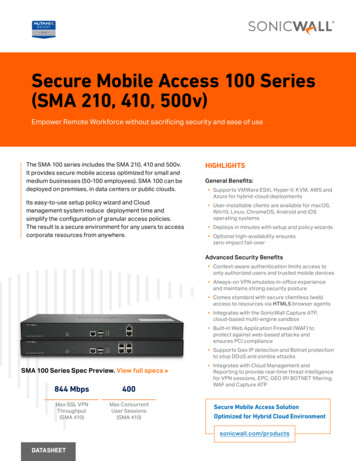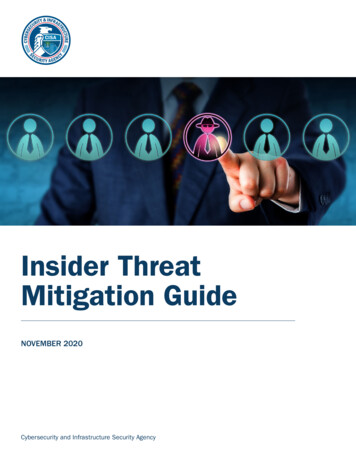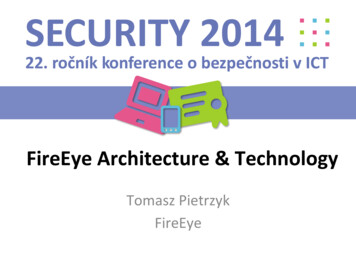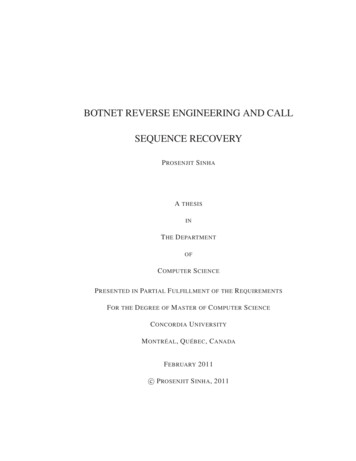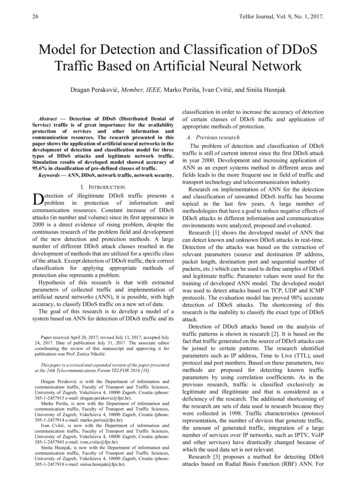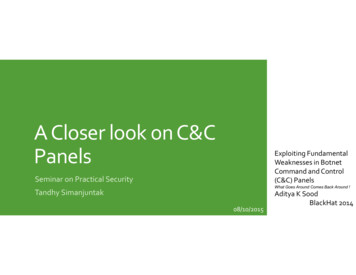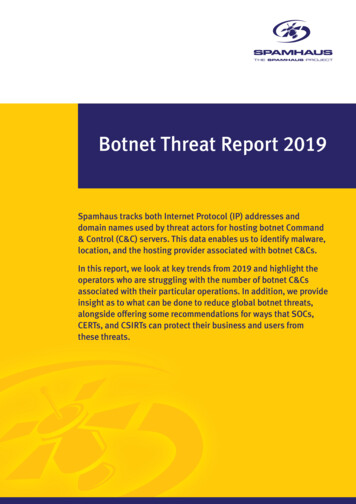
Transcription
Botnet Threat Report 2019Spamhaus tracks both Internet Protocol (IP) addresses anddomain names used by threat actors for hosting botnet Command& Control (C&C) servers. This data enables us to identify malware,location, and the hosting provider associated with botnet C&Cs.In this report, we look at key trends from 2019 and highlight theoperators who are struggling with the number of botnet C&Csassociated with their particular operations. In addition, we provideinsight as to what can be done to reduce global botnet threats,alongside offering some recommendations for ways that SOCs,CERTs, and CSIRTs can protect their business and users fromthese threats.
2 B OTN E T T H R E AT R E PO RT 2 01 9ContentsNumber of botnet C&Cs observed in 20193Geolocation of botnet C&Cs in 20194Malware associated with botnet C&Cs in 20195Number of botnet C&C domain names registered in 20196Most abused top-level domains in 20197Most abused domain registrars in 20198New bulletproof hosting operator increased numberof botnet C&Cs in 20199Botnet C&Cs resulting from fraudulent sign-ups in 201910ISPs hosting botnet C&Cs in 201911Conclusion14Recommended precautionary actions15About Spamhaus16
B OTN E T T H R E AT R E PO RT 2 01 93Number of botnet C&Csobserved in 2019Botnet controllers – a briefexplanationResearchers at Spamhaus Malware Labs identified and blocked 17,602botnet C&C servers hosted on 1,210 different networks. That is anenormous 71.5% increase from the number of botnet C&Cs seen in 2018.Since 2017, the number of newly detected botnet C&Cs has almostdoubled from 9,500 to 17,602.A ‘botnet controller,’ ‘botnet C2’ or ‘botnetcommand & control’ server, is commonlyabbreviated to ‘botnet C&C.’ Fraudstersuse these to both control malware infectedmachines and to extract personal andvaluable data from malware-infected victims.Botnet C&Cs play a vital role in operationsconducted by cybercriminals who areusing infected machines to send out spam,ransomware, launch DDoS attacks, commite-banking fraud, click-fraud or to minecryptocurrencies such as 6029,500201410,26320152016Desktop computers and mobile devices, likesmartphones, aren’t the only machines whichcan become infected. There is an increasingnumber of devices which are connected tothe internet, for example, the Internet ofThings (IoT) devices, such as webcams, ornetwork attached storage (NAS). These arealso at risk of becoming infected.201720182019To understand how ‘popular’ botnet C&Cs were as a cybercriminal’s vectorof choice in 2019, we reviewed the Spamhaus Block List (SBL). We lookedat how many listings on this blocklist were issued for botnet C&Cs. In 2019,almost every other SBL listing issued by Spamhaus was for a botnet C&Cserver, another significant annual increase:Botnet C&Cs as a percentage of all SBL listings 2017–1915%25%41%201720182019
4 B OT N E T T H R E AT R E PO RT 2 01 9Geolocation of botnetC&Cs in 2019RankBotnetC&CsCountry% change14,712Russia 143%24,007United States 76%Russia takes the top spot: Having spent several years as the top countryfor hosting botnet C&Cs, the United States was knocked off its number onespot in 2019 by Russia, which experienced a 143% increase in botnet C&Ctraffic.31,441Netherlands 33%4770China 390%5691France 97%6585Germany 28%This increase doesn’t surprise us. Law enforcement is less focused oninternet abuse in Russia than in Western countries, and many of thoseproviding the internet infrastructure in Russia have more lax registrationprocedures. Later in this report it will be shown that Russia is the mostfrequently recurring location of Internet Service Providers who are hostingthe highest volumes of botnet C&C traffic on their networks.7423Luxembourg—8401Great Britain 31%9314Greece—10300Ukraine 13%11274Bulgaria 57%12256Switzerland13245Canada 5%14243Romania 63%15157Serbia16117LithuaniaDepartures: Chile, Italy, Malaysia, Poland, South Africa and Turkey alldropped off the Top Twenty list in 2019.17114India1897SingaporeNew entries: Luxemburg (#7), Greece (#9), Serbia (#15), India (#17),Sweden (#19) and Argentina (#20) were all new entries to the list in 2019.1996Sweden—2094Argentina—China leaps up the chart: In one year, China has moved up the chart tofourth place, up from thirteenth place in 2018. It has experienced a 390%increase in the number of botnets it hosted in 2019. This percentageincrease was only surpassed by Switzerland, which experienced a massive1,119% increase from 21 in 2018, to 256 in 2019.191378 365 1221161591014114171820 1,119%—–34%—–20%
5 B OT N E T T H R E AT R E PO RT 2 01 9Malware associated withbotnet C&Cs in 2019In 2019, some malware families almost completely disappeared, whileothers evolved.LokiCredential Stealers: Nearly 60% of the newly detected botnet C&Cs in2019 were associated with credential stealers.Lokibot not only remained in the #1 position but also increased its number ofassociated botnet C&Cs by 74%, compared to 2018 figures. Fellow credentialstealer AZORult joined Lokibot at the top of the chart, in the #2 position.2,3474,07520182019TrickBotEmotet TrickBot: In 2019, we observed an increase in Emotet and TrickBotmalspam campaigns and infections. Traditionally, these two malware familieshave been used by miscreants to commit ebanking fraud. However, over thepast two years, we have seen threat actors moving away from the traditionalebanking fraud model to a Pay-Per-Install (PPI) model. In 2019, Emotetand TrickBot were extremely active, predominantly with Emotet eitherpropagating itself, or being used to drop additional ransomware i.e.TrickBot.24173420182019NanoCoreRemote Access Tools (RATs): In addition to credential stealers anddroppers, RATs were the second highest malware family, accounting for19% of botnet C&Cs.3221,15920182019In 2018 we reported that a large amount of RAT botnet C&C infrastructurewas associated with Adwind/Jbifrost, but in 2019 this particular RATreduced by 78%. It was quickly replaced with NanoCore, which increasedby 181% in 2019 and rose to #3 spot on our chart.Another RAT that disappeared in 2019 was ImminentRAT, which was takendown by the Australian Federal Police (AFP) in 2019.1New entries: Credential stealers: Predator Stealer (#9), KPOTStealer (#12)and HawkEye (18), RATs: QuasarRAT (#16), ebanking Trojan: Dridex (#17)and IcediD (#19).Malware families associated with 2019 botnet C&C 0001 2 3 4 5 6 7 8 9 10 11 12 13 14 15 16 17 18 19 20 —Rank1MalwareNoteLokibotCredential Stealer% change 74%2AZORultCredential Stealer 190%3NanoCoreRemote Access Tool (RAT) 181%4PonyDropper/Credential Stealer5TrickBote-banking trojan 173%6Gozie-banking trojan 76%7EmotetDropper/Backdoor8RemocsRATRemote Access Tool (RAT)–23%–23% 147%9Predator Stealer Credential Stealer10Adwind/JBifrostRemote Access Tool (RAT)–78%11NetWireRemote Access Tool (RAT) 98%12KPOTStealerCredential Stealer—13ArkeiStealerCredential Stealer 197%14NjRATRemote Access Tool (RAT) 290%15AgentTeslaKeyLogger/Credential Stealer16QuasarRATRemote Access Tool (RAT)17Dridexe-banking trojan—18HawkEyeCredential Stealer—19IcedIDe-banking trojan20CoinMinerVarious crypto currency miners—OthersOther malware families—–4%——–8%—
6 B OT N E T T H R E AT R E PO RT 2 01 9Number of botnet C&C domainnames registered in 2019The number of domain name registrations for botnet C&C hosting in2019 dropped 71% to 20,342. Our experts believe there are two reasonsfor this:1. Domain name generation algorithms (DGAs) were commonly used bycybercriminals to make their botnet C&C infrastructure more resilientagainst takedown efforts and seizures conducted by law enforcementagencies or IT researchers. However, in 2019, we saw a 42% reductionin their use.DGA’s evidently have become less interesting and reliable to those usingthem. In our opinion the main drivers for this are combined industryefforts, easier wholesale blocking of DGA registrations and the increasedavailability of peer-to-peer (P2P) communication mechanisms. These daysDGAs have mostly become a fallback mechanism.2. There is a large supply of compromised websites. The numbers weare including in this report exclude hijacked domain names, which aredomains that are owned by non-cybercriminals that were used withoutpermission, and domains on ‘free sub-domain’ provider services. Given theplentiful supply of these compromised websites it makes more sense forcybercriminals to utilize these domain names, rather than purchase newones. From a financial perspective these domain names are free, also thereis no paper trail, which in turn protects the identity of the cybercriminal.Domain name registrations for botnet C&C hostings 030,00020,00020,34210,0000201720182019 40%–71%The importance of domain names:Cybercriminals prefer to use a domain nameregistered exclusively to host the botnet C&C.A dedicated domain name allows them tofire up a new virtual private server (VPS),load the botnet C&C kit, and immediately beback in contact with their botnet after their(former) hosting provider shuts down theirbotnet C&C server. Not having to changethe configuration of each infected computer(bot) on the botnet is a major advantage.
7 B OT N E T T H R E AT R E PO RT 2 01 9Most abused top-level domainsin 2019Top-level domains (TLDs) – a briefoverviewExcept for .ru & .com, all the TLDs that appeared on our 2018 listings saw asignificant reduction in the number of botnet C&Cs associated with them. Weassume that part of the reason is due to the reduction, as mentioned above,in domain registrations for botnet C&Cs. We’d also like to hope that theseregistries have taken positive steps to remove bad domains from their TLDs.There are several different top-level domainsincluding:Generic TLDs (gTLDs) – can be usedby anyone.com & .net: These top two TLDs accounted for approximately 50% of thebotnet C&Cs in 2019. Taking into account the sheer size of both thesezones, the diversity of the .com and .net registrar ecosystem and thesomewhat complicated situation around abuse policies (see the recentdiscussions at ICANN trying to define ‘DNS Abuse’)2, we do not see thischanging anytime soon.Country code TLDs (ccTLDs) – some haverestricted use within a particular countryor region; however, others are licensed forgeneral use giving the same functionalityof gTLDsDecentralized TLDs (dTLDs) – independenttop-level domains that are not under thecontrol of ICANNGlobal Registry Services Ltd: Eight top-level domains (TLDs) dropped offthe most abused TLD Top 20 list in 2019. Six of those eight are managed byGlobal Registry Services Ltd, who have clearly made a concerted effort toclean up their TLDs.New entries: .net (#2), .cm (#6), .org (#10), .eu (#14), icu (#16), su (#17),site (#18) & name (#20) have all made it onto the Top 20 list in 2019.bit: In our 2018 Botnet Threat Report, we raised concerns about theincrease of botnet C&C domain names hosted on the decentralized TLD .bit.In Q2 2019, OpenNIC voted to drop .bit from their resolvers 3. As a result, anybotnet that relied on OpenNIC to resolve .bit stopped functioning, leading tothe number of botnet C&C domains within .bit dropping to almost zero.pw: This TLD topped the rankings in 2018; however, we observed a 92%reduction in the amount of botnet C&Cs associated with .pw in 2019,dropping it down to #5.Top abused TLDs – number of domains15,35920,00015,00010,00001,671, 16631,1401,0196 01 2 3 4 5 6 7 8 9 10 11 12 13 14 15 16 17 18 19 20RankTLDNote% change1comgTLD 30%2netgTLD—3ruccTLD of Russia4infogTLD5pwccTLD of Palau6cmoriginally ccTLD, now effectively gTLD7topgTLD–90%8tkoriginally ccTLD, now effectively gTLD–86%9gaoriginally ccTLD, now effectively y ccTLD, now effectively gTLD–70%13mloriginally ccTLD, now effectively gTLD–90%14euccTLD of European Union15gqoriginally ccTLD, now effectively gTLD16icugTLD—17succTLD of Soviet Union—18sitegTLD—19clubgTLD–86%20namegTLD— 41%–1%–92%——–83%
8 B OT N E T T H R E AT R E PO RT 2 01 9Most abused domain registrarsin 2019Fast fluxCybercriminals need to find a sponsoring registrar to get a botnet C&Cdomain name registered. Registrars can’t easily detect all fraudulentregistrations or registrations of domains for criminal use before thesedomains go live. However, the ‘life span’ of criminal domains on legitimate,well-run, registrars tends to be quite short.Botnets use this DNS technique to obscurephishing sites, or domains for downloadingmalware. This is done by placing the phishingor malware behind an ever-changing networkof compromised hosts, which act as proxies.Namecheap was (again) the most abused registrar: Around 25% of allbotnet C&C domain names were registered through this US-based registrar.It’s the third consecutive time that Namecheap has held the pole positionin our annual ranking of most abused domain registrars.Key-Systems used for fast flux hosting: In 2019, we saw an increase offraudulent domain registrations with Key-Systems. A key point to note isthat many of the C&C domains that were hosted on fast flux networks wereregistered through this particular registrar.Hosting Concepts used for bulletproof hosting: The new bulletproof hostingoutfit Spamhaus identified in the latter half of 2019 4 has been heavilyutilising this registrar for registering botnet C&C domains for their customers.As a result, this Dutch registrar made it onto our chart for the first time.Alpnames shut down by ICANN: In March 2019, ICANN shut down thisGibraltar based domain registrar. As a result, the number of newly registeredbotnet C&Cs domain names at this registrar dropped down to zero.New entries: Key Systems (#5), WebNic.cc (#6), Hosting Concepts (#8),55hl.com (#9), Hostinger (#13), GMO (#14).Departures: Out of the five domain registrars that dropped off the TopTwenty list in 2019 (excluding Alpnames), four were based in the UnitedStates: Enom, Network Solutions (aka web.com), Register.com & Tucows.RankFraudulent domain name 022992782703548551,0008898497567487261,301, 2231, 51752,0001 2 3 4 5 6 7 8 9 10 11 12 13 14 15 16 17 18 19 20RegistrarCountry1NamecheapUnited States% SiloUnited States 54%5Key mChina8Hosting t (aka DropCatch) United States 216%11CentralNicGreat Britain 114%12RU-CenterRussia 159%13HostingerLithuania14GMOJapan—15Eranet InternationalChina 214%16OnlineNICChina 84%17ArsysSpain 14%18Xi NetChina–18%19AlibabaChina–86%20R01Russia 42% 160%—
9 B OT N E T T H R E AT R E PO RT 2 01 9New bulletproof hostingoperator increased number ofbotnet C&Cs in 2019From all of the botnet C&Cs Spamhaus observed in 2019, 77% were as aresult of fraudulent sign-ups, compared to 61% in 2019. This 16% increase,we believe, can be attributed to the new bulletproof hosting operationwe previously mentioned.5 This new set-up operates with a new modusoperandi, providing its clients with significant benefits over previousbulletproof hosting models.Fraudulent sign-ups 2018–1961%201877%2019 16%What is a ‘fraudulent sign-up’?This is where a miscreant is using a fake,or stolen identity, to sign-up for a service.This service is usually a VPS or a dedicatedserver, for the sole purpose of using it forhosting a botnet C&C.
10 B OTN E T T H R E AT R E PO RT 20 19Botnet C&Cs resulting fromfraudulent sign-ups in 2019How to utilize the BCLWhen a botnet C&C is noted to be the result of a fraudulent sign-up, it issubject to a listing on the Spamhaus Botnet C&C List (BCL). The graph belowshows the overall number of botnet C&C listings versus the number of botnetC&C listings on the BCL between 2014–2019.In 2019, we averaged approximately 1,130 BCL listings per month. This ismore than double the average in 2018 (530 per month).With the above mentioned new bulletproof hosting operation, we feelconfident that the number of fraudulent sign-ups at hosting providerswill increase in 2020 unless hosting providers implement more robustcustomer verification processes.Total of newly detected botnet C&C listings vs newly detectedBCL listings 2014–2019The dark side of the net controllersIncluding compromised websites,compromised servers andfraudulent sign-ups20182019BCL listingsFraudulent sign-ups onlySpamhaus Botnet C&C Listings (BCL) per ugSepOctNovDecThis is a ‘drop all traffic’ list intended foruse by networks to null route traffic toand from botnet C&Cs. These IP addresseshost no legitimate services or activities,so they can be directly blocked on bothISP and corporate networks without therisk of affecting legitimate traffic. Infectedcomputers that may be present on theirnetworks are effectively rendered harmless.These statistics exclude botnet C&Cshosted on the dark web (like Tor). The useof such anonymization networks by botnetoperators started becoming more popularin 2016. This popularity is more than likelydriven by the fact that the location of thebotnet C&C is unidentifiable; making thetakedown of a server almost impossible.This trend has continued into 2019.However, a vast amount of the botnet C&Csdetected by Spamhaus Malware Labs in2019 were still hosted on the clear web.For anonymization services like Tor, werecommend a whitelist approach: In general,block access to anonymization servicesexcept for those users who need it (opt-in).
11 B OTN E T T H R E AT R E PO RT 20 19ISPs hosting botnet C&Csin 2019Before we reveal which hosting ISPs had the largest number of botnet C&Cson their networks in 2019, it is essential to understand some key points:Preventing Botnet C&Cs on compromised servers or websites: It can bedifficult for an ISP or hosting provider to do this since these are often underthe control of the customer. Many servers and websites are running outdatedsoftware, making them vulnerable to attacks from the internet. We have seenthat some of the more proactive ISPs and hosting providers are now usingnewer tools and methods to track down outdated software and monitor botnetC&C traffic. Of course, blocking traffic to known botnet C&Cs is a good start.Preventing Botnet C&Cs on servers used solely for hosting a botnet C&C:ISPs have far more control in this situation since when a new customer triesto sign-up, a customer verification/vetting process should take place beforecommissioning the service. Where ISPs have a high number of BCL listings(botnet C&Cs hosted on servers solely for that purpose, i.e., a fraudulentsign-up) it highlights one of the following issues:1. ISPs are not following best practices for customer verification processes.2. ISPs are not ensuring that ALL their resellers are following soundcustomer verification practices.3. Employees or owners of ISPs are directly benefiting from fraudulentsign-ups, i.e., knowingly taking money from miscreants in return forhosting their botnet C&Cs.The larger the ISP, the larger the volumes of abuse. While it may seemobvious, it’s important to remember that due to their increased hostingcapabilities, the bigger ISPs and hosting providers have a higher volume ofpoorly patched servers and websites on their network.Outdated software makes foran easy targetIt is a simple task for a cybercriminal to scanthe internet for servers or websites that arerunning outdated or vulnerable software.Some of the most popular open sourcecontent management systems (CMS) likeWordPress, Joomla, Typo3 or Drupal areespecially popular targets, due to the highnumber of poorly maintained installations ofthese packages.Proxy nodesBotnet operators do not only use hostingproviders and anonymization services tohost their botnet infrastructure. SpamhausMalware Labs has also seen an increaseof malware-infected machines (bots) thatcybercriminals turn into a proxy node.In doing so, these bots become a part ofthe botnet infrastructure and are used torelay botnet C&C communications fromother infected machines to the real botnetcontroller. While this is not a new techniquethat has appeared in 2018, malware familieslike Qadars, Quakbot, and others have beenusing this approach for several years; wehave observed a substantial increase ofHeodo/Emotet infected machines that havebecome a part of the Heodo/Emotet botnetinfrastructure.It is worth noting that if you think that yourinternet connection is suddenly runningmore slowly than expected, then yourcomputer could potentially be infected andbe acting as a proxy for a botnet operation.
B OTN E T T H R E AT R E PO RT 20 1912Total botnet C&C hosting numbers by ISP, includingcompromised websites, compromised servers andfraudulent sign-upsRankC&CsNetworkCountryBotnet C&C hosting numbers by ISP, as a result offraudulent sign-ups only (BCL)% changeRankC&CsNetworkCountry% change11,581cloudflare.comUnited States 125%11,581cloudflare.comUnited States 125%2629alibaba-inc.comChina 240%2626alibaba-inc.comChina 284%3507ovh.comFrance 42%3476simplecloud.ruRussia 3,073%4483simplecloud.ruRussia 2,741%4432ovh.netFrance 89%5407ispserver.comRussia 267%5397ispserver.comRussia 493%6338reg.ruRussia 412%6357reg.ruRussia 693%7319timeweb.ruRussia 187%7280mtw.ruRussia 264% ia 289% 264%10244stajazk.ruRussia 495%11233colocrossing.comUnited States colocrossing.comUnited States11247marosnet.ruRussia 1,444%—12244stajazk.ruRussia 495%12233marosnet.ruRussia Russia–6%14222m247.roRomania 500%14219m247.roRomania15201spacenet.ruRussia 3,250%15194spacenet.ruRussia 3,133%16200leaseweb.comNetherlands 74%16171itos.bizRussia 375%17172endurance.comUnited States 251%17160leaseweb.comNetherlands 86%18171mchost.ruRussia 76%18158mchost.ruRussia 95%19171itos.bizRussia ny 131%20156greenvps.netRussia—Cloudflare – the top botnet C&C hosting network: Cloudflare is a ContentDelivery Network (CDN) provider from the US. While they do not directlyhost any content, they provide services to botnet operators, masking theactual location of the botnet controller and protecting it from DDoS attacks.Many cybercriminals sign-up for Cloudflare’s free plan with the solepurpose of using it exclusively for hosting a botnet C&C. Usually, such alisting would be placed on our BCL; however, because the hosting of thebotnet C&C is on a Cloudflare shared IP address, it is placed on the SBL. Inthis extraordinary circumstance, we have chosen to list the same figures inboth charts.New entries: simplecloud.ru (BCL #3), ovh.net (BCL #4), reg.ru (BCL #6),fos-vpn.org (BCL #8), stajazk.ru (BCL #10), marosnet.ru (BCL #12), m247.ro(BCL #14), spacenet.ru (BCL #15), itos.biz (BCL #16), netangels.ru (BCL #19),greenvps.net (BCL #20) are all newcomers to our Top Twenty BCL rankings.It is interesting to note that out of these eleven ISPs with botnet C&Cs ontheir network as a result of fraudulent sign-ups, 73% are Russian based.ISPs with only BCL listings: Newcomers greenvps.net and netangles.ru arethe only networks that we have seen with botnet C&C listings on the BCLalone. We weren’t able to find a single compromised server or website thatwas abused for botnet C&C hosting on any of these networks, signalingthat all the sign-ups on these two networks were fraudulent. 526%
13 B OTN E T T H R E AT R E PO RT 20 19Recurring entries: Unfortunately, with the exception of selectel.ru, all theISPs listed on our 2018 Top Twenty BCL list saw a significant increase in theamount of botnet C&Cs on their networks as a result of fake registrationsin 2019.Departures: gerber-edv.net & anmaxx.net: We suspect both have beenrebranded, and swiftway.net has disappeared. Meanwhile the followingcompanies appear to be successfully trading, and therefore we assumehave appropriately dealt with the botnet C&C abuse on their networks;iliad.fr, morene.host, neohost.com.ua, dataclub.biz, hostsailor.com,eksenbilisim.com.tr, digitalocean.com, choopa.com, melbicom.net, zare.com, and tencent.com.
14 BOTN E T T H R E AT R E PO RT 2 01 9ConclusionEast/West Divide: On reading this report the divide between East andWest is obvious, with the East lagging behind the West, both in termsof robust sign-up procedures, and in enforcement focused on takingdown cybercriminal activity. Criminals will always follow the path of leastresistance, be that registering their domain with a Chinese registrar orusing a Russian ISP, neither of which follow rigorous sign-up processes.Emotet & Trickbot: Our researchers have noted a huge increase in thenumber of Emotet and TrickBot malspam campaigns and infections.Despite having a ‘holiday’ 6 in June, July and August, Emotet ramped up itsactivity towards the end of last year.7 Emotet’s behavior and characteristicsare constantly changing to make it more and more dangerous.DGA usage is dropping. This is good news, and illustrates that with acombined effort from the industry, positive changes can be made.New botnet bulletproof hosting operator: We do have concerns inregard to the appearance of this operator. Worryingly, the set-up forcybercriminals is more cost-effective, less risky, and provides greater agilitywhen compared with that of ‘conventional’ bulletproof hosting, makingit easier for them to host all kinds of badness. It is crucial that hostingproviders across the globe stop allowing customers to fraudulently sign upfor services. Otherwise, the 16% increase in botnet C&Cs associated withfraudulent sign-ups in 2019 will continue to rise in 2020.Compromised websites: We have seen a shift to cybercriminals usingcompromised website domain names for their botnet C&Cs, rather thanbuying their own domains. This adds complexity to take downs. Therefore,it is imperative that everyone who runs a website ensures theirs is secure.
15 B OTN E T T H R E AT R E PO RT 20 19Recommended precautionaryactionsIn such a rapidly changing environment a flexible and swift (if notautomated) approach is required by those who protect networks and users.In addition to current security measures that are currently implemented,based on the botnet C&C threats observed in 2019, we recommend theadditional following precautionary actions:" Choose your internet infrastructure providers, e.g. registrars andISPs, wisely. Picking providers with poor reputation can have seriousconsequences for business operations. ‘Cheap’ should rarely be adeciding factor in a business decision making process." Authentication logs should be monitored to determine what regulartraffic looks like so when anomalies occur, they will be obvious. Ifpossible, do not allow authentication to a network via multiple points tokeep protection needs simple." To combat threats from botnet C&Cs utilizing dTLDs look to BorderGateway Protocol data feeds that automatically block connections to IPaddresses associated with botnet C&Cs." To avoid websites being hacked by cybercriminals to host a botnet C&C,always ensure the installed CMS, such as WordPress or Typo3, includingany installed 3rd party plugins, are up-to-date." When operating a server, ensure that the operating system (OS) is up todate and any installed software such as Apache2 or PHP is running withthe latest security patches." Block access to cryptocurrency mining pools by default, and provideusers who require access with the ability to ‘opt-in.’" Block traffic to anonymization services like Tor by default, and provideusers who require access with the ability to ‘opt-in.’" Avoid your server being one of the many that are compromised on adaily basis as a result of brute force or stolen SSH passwords. UseSSH key authentication whenever possible or deploy two-factorauthentication (2FA).
16 B OTN E T T H R E AT R E PO RT 20 19About SpamhausThe Spamhaus Project is a non-profit organization dedicated tomaking the internet a better place for everyone. We have beenproducing industry leading threat intelligence datasets for overtwo decades. These datasets protect three billion end usersagainst malicious activity including spam, malware and phishing.As the internet continues to become ever more integrated in our day-today lives, so do the threats related to malicious activities. The processof identifying bad behaviors is constantly evolving, with cybercriminalsrapidly developing new ways of targeting users.Spamhaus works together with the wider internet community, includingnetwork operators to define what acceptable and appropriate behaviorlooks like online. We then shine a light on behavior that doesn’t meetthese policies. We identify and list internet infrastructure, for example anIP address, which is either currently exhibiting bad behavior or, based onour experience, is likely to do so. Our datasets are used to protect usersfrom infrastructure which show malicious intent. Additionally, our data canprovide users with deeper insights, enabling them to rapidly investigateand remediate incidents.A broad community of organizations, network operators and individualsshare their data with us to help improve the quality and reliability of ourdatasets. An experienced team of security researchers use heuristics,machine learning and manual investigations to carefully analyze, scoreand list infrastructure entities. Our community-led approach, impartialityand dedication has led us to become trusted by Internet Service Providers(ISPs), Email Service Providers (ESPs), enterprise business and lawenforcement, among others.References1 ntrol-of-victims%E2%80%99-pcs].2 https://66.schedule.icann.org/
domain names used by threat actors for hosting botnet Command & Control (C&C) servers. This data enables us to identify malware, location, and the hosting provider associated with botnet C&Cs. In this report, we look at key trends from 2019 and highlight the . doubled from 9,500 to 17,602. Botnet controllers - a brief explanation
